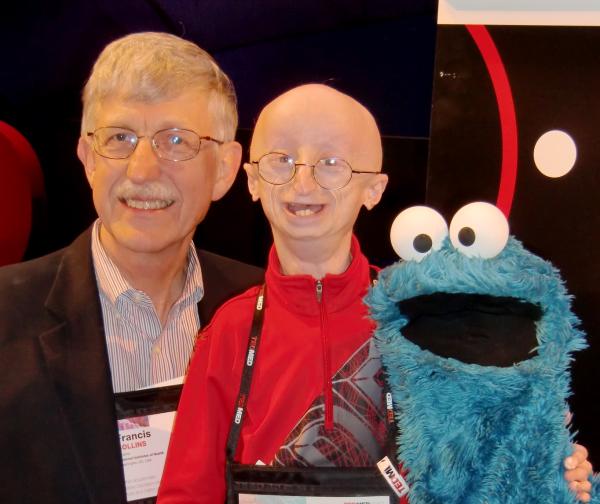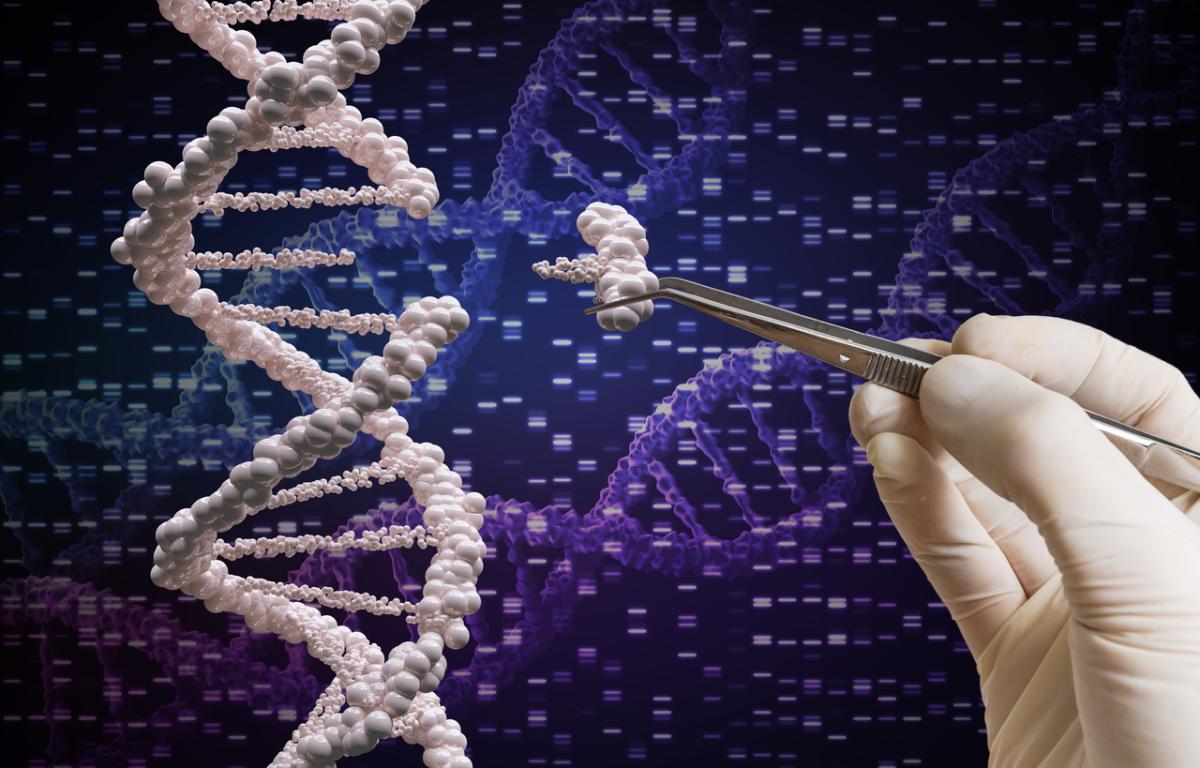Drilling Down Into DNA and Disease
Catching Up With Former NIH Director Francis Collins

Former NIH Director Francis Collins is leading efforts to better understand the links between our genes and our health.
It has been 20 years since researchers around the world successfully mapped most of the roughly 20,000 genes that make up the human genome. Former NIH Director Francis Collins, M.D., Ph.D. led the Human Genome Project through most of its 13-year progression and continues to push the limits of genetics today. As we celebrate National DNA Day on April 25, the 71st anniversary of the publication of DNA’s double-helix structure, we took some time to catch up with Dr. Collins and learn what he’s been up to since he stepped down as NIH Director in December 2021.
The dozen or so researchers in Dr. Collins’s lab focus on the role of genes in a variety of diseases, ranging from conditions caused by rare mutations in single genes to common ailments influenced by the interplay of hundreds of genes, lifestyle behaviors, and environmental factors. His two main research interests are type 2 diabetes and Hutchinson-Gilford progeria syndrome, a rare disorder that causes exceptionally rapid aging in children.
“I like the idea of having such a broad representation of what is now possible in genetics and genomics within one laboratory,” Dr. Collins says. “I think the groups studying different diseases learn from each other, in spite of their different research strategies.”
One team of researchers under his supervision is pursuing efforts to cure progeria, an endeavor made more achievable due to the fact that the condition is caused in almost all cases by a misspelling of just one ‘letter’ in the LMNA gene. While progeria is rare, affecting only 1 in 8 million births, its effects are heartbreaking: children who seemed normal at birth stop growing and soon begin to age rapidly.

Dr. Collins poses with his friend Sam Berns, a young man with progeria, who later passed away at the age of 17.
“They’re normal kids in bodies that are aging at about seven times the normal rate,” Dr. Collins says. “Before we came up with a treatment, most of them would die in their early teens from the same kind of progressive heart disease and stroke you see in people in their 70s or 80s.”
His laboratory was the first to identify the cause: a single ‘C’ changed to a ‘T’ in a protein-coding part of the LMNA gene. When working properly, LMNA codes for a protein, lamin A, that is important for creating the scaffolding needed to build the cell’s nucleus.
“This mutation causes a toxic form of the protein to be produced, which causes cells to have a hard time dividing and regrouping with their new nuclei,” Dr. Collins explains. “This protein seriously gums up the works, so cells can only go through so many cell divisions before they die off. These kids’ cells are running out of gas far too soon.”
Fortunately, Dr. Collins says, it turned out that a lot was already known about lamin A, and a drug that had originally been developed for treating cancer had the right properties to treat progeria. Within four years of discovering the mutation responsible for progeria, Dr. Collins’ collaborators at the Progeria Research Foundation began a clinical trial using that drug.
“The treatment is now approved by the Food and Drug Administration, so virtually every progeria kid in the world — and there's only about 200 known cases right now — is taking this drug,” Dr. Collins says. “It’s very gratifying to see how that has extended lifespan. My progeria research team now includes a young man with progeria who is 28 years old. Before this drug treatment, there had been almost no survivors beyond age 20 with classic progeria.”
Still, while that treatment slows disease progression and extends life, it isn’t a cure. That’s what Dr. Collins and his colleagues are working on now, aiming to use gene editing to fix the mutation responsible. Working with David Liu, Ph.D., at the Broad Institute at the Massachusetts Institute of Technology, a world-renowned expert in designing the tools to find and replace errant genes, the team has seen dramatic success in mouse models so far.1 The treated animals lived two and a half times longer than those not given the gene-editing treatment, reaching nearly the normal lifespan for mice.

After helping shepherd a treatment for progeria from the bench to the bedside, Dr. Collins is now assisting with efforts to develop a cure for the disease that fixes the genetic changes responsible for it.
On the other end of the spectrum of genomic complexity, Dr. Collins’ team is attempting to identify and understand the many genes involved in type 2 diabetes. A disease that affects an estimated 38 million Americans and nearly 100 million people the world over, type 2 diabetes is one of the most common maladies in higher-income countries. Beginning in 2007, the Collins laboratory was one of the first to apply genomics research to diabetes and contributed to the identification of the first 10 genetic suspects. More recently, one of Dr. Collins' graduate students led the latest update to that research, which compared the genomes of over 400,000 diabetes patients and more than 2 million people without the condition. The research identified 611 places in the genome where variations increase the risk of type 2 diabetes.2
“It’s a really complicated situation,” Dr. Collins says. “One of my mentors referred to diabetes as ‘the geneticist’s nightmare’ because it’s so darn complicated. But we’re starting to wake up from that nightmare, because the science is making it possible to dig through all this complexity and arrive at some really important insights about the disease.”

Studying the genetics of type 2 diabetes is complicated by the fact that the disease is influenced not only by many genes but also lifestyle factors like diet.
One way Dr. Collins’s team is doing this is by using human stem cells to test what happens when genes thought to influence diabetes susceptibility are turned off, one-by-one.3 The 20 genes they have looked at so far are prime candidates for influencing the risk of type 2 diabetes because they are thought to play a role in the functioning of the ‘beta’ cells in the pancreas that normally produce the hormone, insulin, that type 2 diabetics fail to make in adequate amounts.
“Most of the genes we tested had a pretty significant effect, so we’re on the right track here,” Dr. Collins says. “Of course, 20 is just a small subset of 611, so this is the start of a much bigger universe of gene effects that we need to understand, not just in my lab but for the whole field.”
Indeed, as Dr. Collins argues, we’ve arrived at an exciting new frontier — not just for progeria and type 2 diabetes, but for all of biology and medicine.
“It is an exhilarating time to be involved in biomedical research,” Dr. Collins says. “There are so many experiments that are possible now that I would not have dreamed would appear in my lifetime. We're on an exponential curve of learning how life works, how disease happens, and what to do about it. We are learning things that have been out of reach for all of human history. Those discoveries are happening every day.”
Subscribe to our weekly newsletter to stay up-to-date on the latest breakthroughs in the NIH Intramural Research Program.
References:
[1] Koblan LW, Erdos MR, Wison C, Cabral WA, Levy JM, Xiong ZM, Tavarez UL, Davison LM, Gete YG, Mao X, Newby GA, Doherty SP, Nariso N, Sheng Q, Krilow C, Lin CY, Gordon LB, Cao K, Collins FS, Brown JD, Liu DR. In vivo base editing rescues Hutchinson-Gilford progeria syndrome in mice. Nature. 2021 Jan 28; 589:608-614. doi: 10:1038/s41586-020-03086-7.
[2] Suzuki, K., Hatzikotoulas, K., Southam, L. et al. Genetic drivers of heterogeneity in type 2 diabetes pathophysiology. Nature. 2024 Feb. 19:627, 347–357. doi: 10.1038/s41586-024-07019-6.
[3] Xue D, Narisu N, Taylor DL, Zhang M, Grenko C, Taylor HJ, Yan T, Tang X, Sinha N, Zhu J, Vandana JJ, Chong CAN, Lee A, Mansell EC, Swift AJ, Erdos MR, Zhong A, Bonnycastle LL, Zhou T, Chen S, Collins FS. Functional interrogation of twenty type 2 diabetes-associated genes using isogenic human embryonic stem cell-derived b-like cells. Cell Metabol. 2023 Nov. 7; 35:1897-1914. doi:10.1016/j.cmet.2023.09.013.
Related Blog Posts
This page was last updated on Thursday, April 25, 2024
